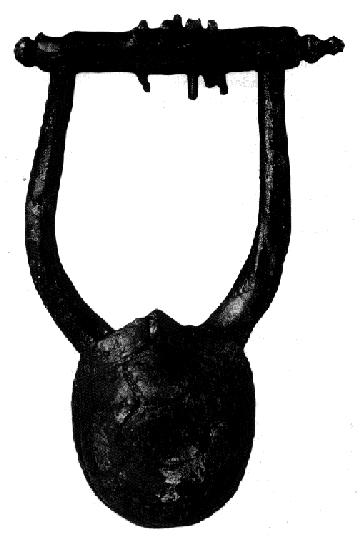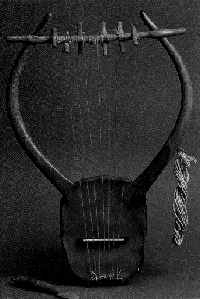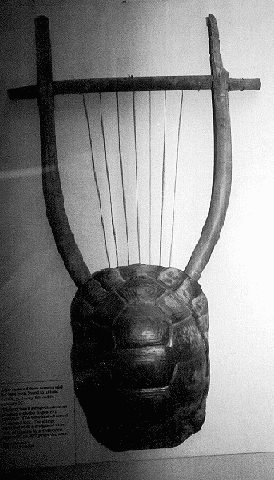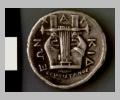Strings
Strings have a long history. They appear in history from 2000 BC in
Mesopotamie.
When the Greek culture was growing, de development of strings was accelerated.
You played with your fingers or with a plectrum. Striking (or bowing or whatever the
term is in English) like on a violon started in the Middle Ages.
Lyres can be divided into two types: those where the sound box was made
of the
shield of a turtle (lyre and barbitos) and those made of
wood (kithara and phorminx). This difference had a consequence: the first ones were used
by amateur musicians, the latter by pro's. The latter had therefore a bigger status, which
means that it was frequently portrayd and named in literature. However, the use of the
different names was not that consequent, something we 've seen also with the
copper instruments !
The origin of the lyre linked to a myth. Hermes is held as the inventor of it.
When this God had the age of one day, he climbed out of his cradle and on his discovery
of the world he found the shield of a turtle. He stretch the skin of a cow
around it, fixed
two horns through the holes were once the paws of the animal stook out en tied strings
at the horizontal connection between the arms. One day, when Hermes stole some sheep
from the stable of Apollo, the latter was soothed by the sound of the instrument. Hermes
did not get punished and the instrument gained its divine status.


Picture left : Archäologisches Institut der Universität heidelberg
Picture right: Centre for Acropolis Studies, Acropolis Education
 A larger type of the lyre is the barbitos. The arms are langer, the strings also.
The consequence is that the timbre of this type must have been lower. The phorminx and
the kithara hava a wooden sound box. The difference between these two is minimal.
The main difference is the construction and the decoration. The arms of the second are
thicker and are more solid. Therefore, the amount of strings could be 11. On the picture
above you can see that the strings could be tuned. The musician could thus play
in the 3 different genders. The strings were mostly made out of the guts of sheep. The
lowest string was situated near the chest of the player. One played on these instruments
while one was standing upright.
A larger type of the lyre is the barbitos. The arms are langer, the strings also.
The consequence is that the timbre of this type must have been lower. The phorminx and
the kithara hava a wooden sound box. The difference between these two is minimal.
The main difference is the construction and the decoration. The arms of the second are
thicker and are more solid. Therefore, the amount of strings could be 11. On the picture
above you can see that the strings could be tuned. The musician could thus play
in the 3 different genders. The strings were mostly made out of the guts of sheep. The
lowest string was situated near the chest of the player. One played on these instruments
while one was standing upright.
Photo: British museum



Source of these three coins:
http://www.perseus.tufts.edu/cgi-bin/browser?object=Coin&field=Keyword&keyclass=Musical+Instruments&keyword=kithara






